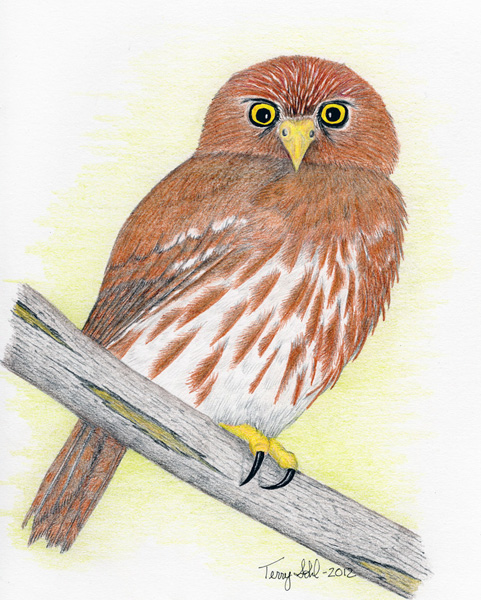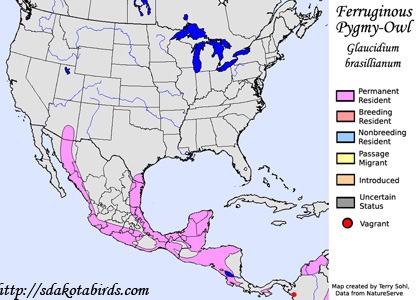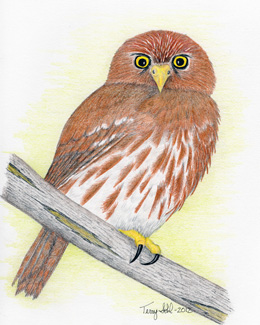| Length: 6.75 inches | Wingspan: 12 inches | Seasonality: Non-resident in South Dakota |
| ID Keys: Rufous-brown overall, obvious streaking on underparts, streaked crown | ||
 The
Ferruginous Pygmy-Owl is a small owl of the tropics, with a range that just
extends into the United States in Arizona. Once common in parts of
Arizona, they have disappeared from much of the region and are now
relatively rare in the United States. They once preferred mesquite stands
along river valleys in Arizona, but much of that habitat has been destroyed.
Competition for nesting cavities may also be contributing to the species'
decline. Ferruginous Pygmy-Owls have a very large range that extends
southward from Arizona, through Mexico and Central America, and into parts
of South America. Owls in different parts of their range may be
specialized feeders on local prey, and there are some indications that
Ferruginous Pygmy-Owls may comprise more than one species.
The
Ferruginous Pygmy-Owl is a small owl of the tropics, with a range that just
extends into the United States in Arizona. Once common in parts of
Arizona, they have disappeared from much of the region and are now
relatively rare in the United States. They once preferred mesquite stands
along river valleys in Arizona, but much of that habitat has been destroyed.
Competition for nesting cavities may also be contributing to the species'
decline. Ferruginous Pygmy-Owls have a very large range that extends
southward from Arizona, through Mexico and Central America, and into parts
of South America. Owls in different parts of their range may be
specialized feeders on local prey, and there are some indications that
Ferruginous Pygmy-Owls may comprise more than one species.
Habitat: Ferruginous Pygmy-Owls can be found in a variety of semi-open habitats throughout much of their range in the tropical Americas. In the small United States portion of its range, they are found in saguaro cactus areas of the Sonoran Desert, and mesquite and live oak thickets in Arizona. When using mesquite or live oak, they are typically found in riparian areas.
Diet: Feeds on a variety of small prey, including large numbers of large insects, as well as small lizards, small rodents, small birds, small snakes, and scorpions.
Behavior: Hunting is most often done near dawn and near dusk, but Ferruginous Pygmy-Owls are often active during the daylight hours. They will observe from a perch and fly out quickly to catch prey when spotted.
Nesting: The nest of a Ferruginous Pygmy-Owl is a cavity in a tree or a cactus. The cavity is often a woodpecker cavity, but it will also use other cavities if present. The female does most of the incubation eggs, but the male will bring food to the female during incubation. Both the male and female will help to raise the young.
Song: Song of the Ferruginous Pygmy-Owl is a series of repeated notes, rapid in pace and with each note slightly higher in pitch than the previous note.
Migration: Considered a permanent resident through its range in the Americas.
Interactive eBird Map: Click here to access an interactive eBird map of Ferruginous Pygmy Owl sightings
Similar Species: Northern Pygmy-Owl
Conservation Status: The IUCN currently lists the Ferruginous Pygmy-Owl as a species of "Least Concern". Globally, the population has a very large range, and isn't threatened with extinction. The species is widespread and common over much of its range in the American tropics. However, it is considered threatened in the U.S. portion of its range, where it has declined significantly in recent decades.
Further Information: 1) Owling.com - Ferruginous Pygmy-Owl
2) Defenders of Wildlife - Ferruginous Pygmy-Owl
3) USGS Bird InfoCenter - Ferruginous Pygmy-Owl
Image Information: Colored pencil drawing by Terry Sohl - March 2012
| Click below for a higher-resolution map |
 |
| South Dakota Status: Non-resident in South Dakota |
Additional Ferruginous Pygmy-Owl Images
Click for a higher-resolution version of these photos

